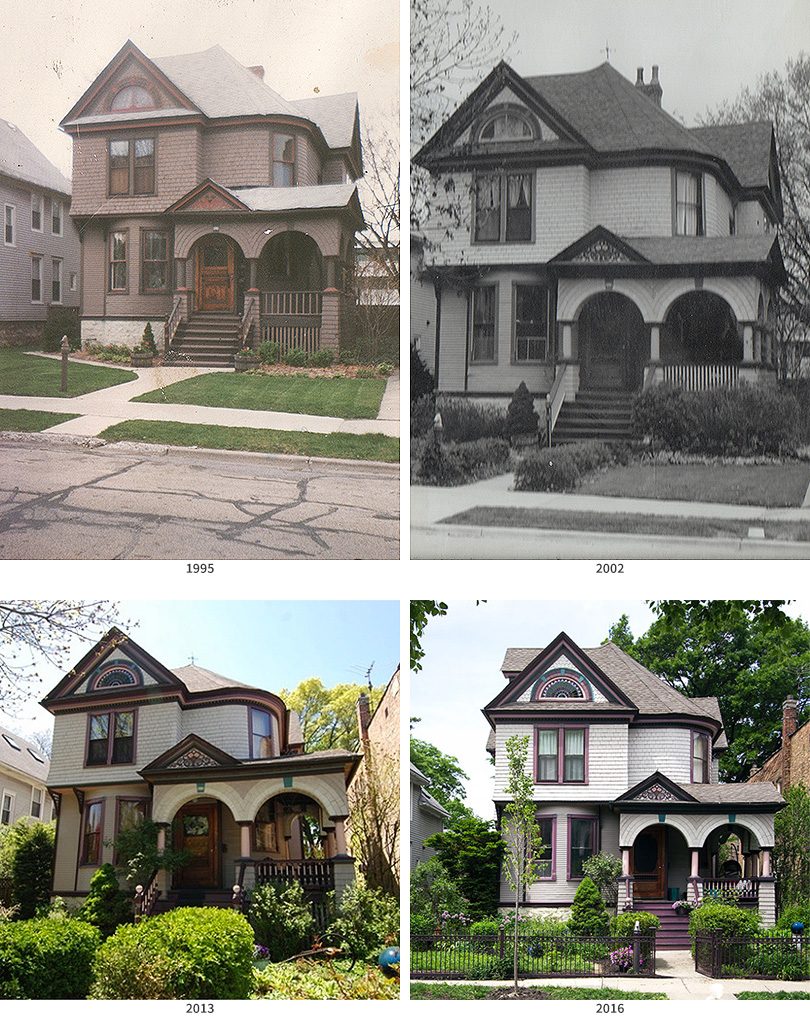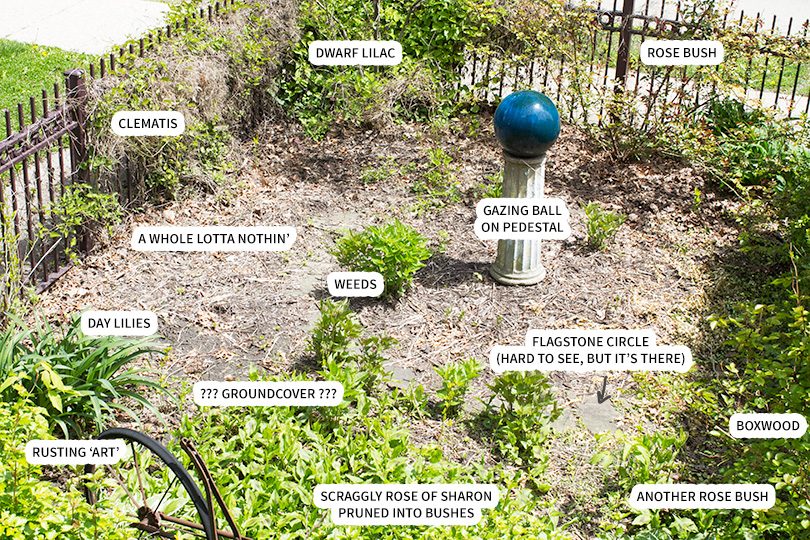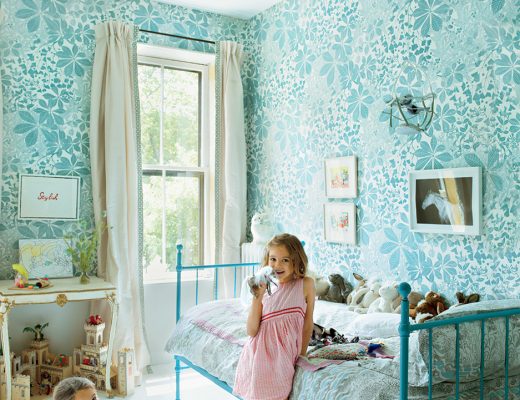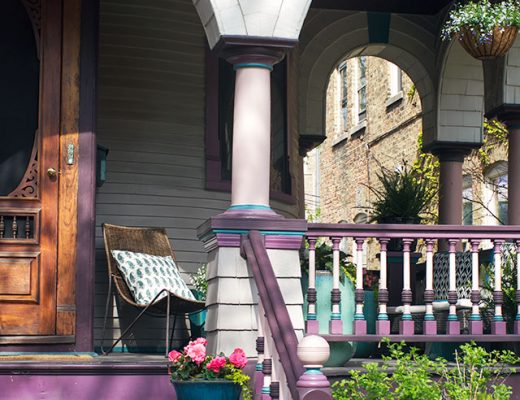This post is sponsored by RISE’s AND not OR home and garden program, but all thoughts and opinions are my own.
I’ve been planning and working on the front yard! I’m still drawn to the idea of a parterre, but I think it may be better suited for the back of the house rather than the front. Instead, I want to incorporate some of those formal elements (namely symmetrical boxwood hedges), but I’ll likely be adding some grass rather than pathways. We can’t grow it in the back because it’s too shady, but the front gets enough sun and some grass would better fit stylistically with the neighborhood. That’s not to say I’m just pulling everything up and laying sod, though that is kind of what the house looked like in the not too distant past!
The previous owners lived here for decades, taking care of this old lady of a house and making improvements, and they left us a handful of photos from over the years. Here’s a couple from before and after the house had been painted, and then a shot of the house when we bought it and again last year.

The majority of houses in our neighborhood have a grass lawn and a few shrubs hugging the house, and our place was no exception. The horse hitching post was there, but the wrought iron fence wasn’t installed until some time after 2002, and the landscaping changed over the years too. Here’s a larger shot of the house when we bought it.

Lush! (And a little overgrown!) The plantings had been added to over time, bit by bit, and it shows. It’s a cottage garden — super charming and casual and appropriate for the house, but with little structure. And what have I come to realize I like most in gardens? Structure. Formality. Simplicity.
I don’t mind spending a full day tending to the garden. The way it’s planted now though, it takes several full days per week, every week from spring through fall, and it’s more than I want to keep up with. Many reactions to my idea of a parterre were along the lines of “oh, boxwood hedges need so much work” but I don’t think so. They need trimming, thinning, and shaping yes, and they’ll benefit from fertilizer and mulch to protect their shallow roots, but it’s a couple of labor-intensive days a couple of times a year, and then they pretty much do their thing. Plus, I’ve come to realize that my favorite garden task is trimming hedges — so satisfying to tidy them up!
RISE (Responsible Industry for a Sound Environment)® recently put me in touch with a Master Gardener to talk about AND not OR — the idea of taking a balanced approach to caring for your garden or yard — which was so helpful as I’ve been planning everything. One of the first things he noticed was the Dwarf Alberta Spruce. “Is it doing well,” he asked? “They tend to get spider mites and need to be sprayed regularly to keep them healthy.” Oh! Well, no. It isn’t doing well — there are dead and brown patches throughout that I was concerned about. I checked it out after our conversation, and yep, that’s the problem! So now that I know what’s causing the trouble, I can save and care for the wee spruce.
Three Types of Gardeners
The AND not OR site has descriptions of three types of gardeners. There are the Picture-Perfect Planners, dedicated to even the most demanding of garden checklists with the perfect flower beds to show for it. The Saturday Savers have places to go and things to do, and yardwork shouldn’t get in the way. And then there are the Daring Doers, never shying away from a good DIY project. (I’m right there between the Planners and the Doers.) There are recommendations for tools, pest and weed control, plant selections, and more to fit each type.
Out front, I’m keeping my level of commitment to garden tasks in mind as I plan. I got started clearing the area and pulling up a ring of flagstone. I like the idea of a circular center focal point, but I didn’t love the execution, so I’m making some changes.

I mentioned before that a bunch of weeds had popped up on this side of the yard. I wasn’t sure what was growing, so I let it grow last year, and then everything got to four feet high without any redeeming aesthetic characteristics. Whoops! They’re starting to grow in again now. Brandon and I have been pulling things out by the roots. I’m focused on preventing them from coming back, and knowing how to get rid of them if they do. I’m still finalizing the plan, but the center area is where I’d like to add grass for another kid-friendly space. Then maybe another hedge along the side, with flowers nearest the sidewalk and foundation shrubs at the back? And keep the gazing ball or replace it with something more my style?
Boxwood Plans
I’ve been reigning in those boxwoods for three years now, so I had some questions about those for the Master Gardener I chatted with too. I explained that I had been rejuvenating them, but that they were still too large for my liking. Do I give up and rip them out (as had been suggested to me in the comments of previous posts)? And what if I’d like to add more? Start everything over from scratch, mix varieties, or stick with what we’ve got? We agreed that mixing varieties isn’t the best look in this case, so it’s really a matter of preference between the other two options.
Start Over!
I could pull everything and start from scratch with a more compact variety. English boxwoods take a hit with cold/wind, but Korean boxwoods do well here. (And Vardar Valley is a newer, promising cultivar. Apparently Mount Vernon has switched over after struggling to maintain older varieties.) It’s a slow-growing plant though, so the house would look pretty bare for a while. The aim here would be to replace what we have with a dwarf type, thus leading to less pruning needed over time.
Work With What You’ve Got!
I don’t know for sure, but there’s a Green Mountain tag left on the boxwoods that line the side of the house, and I’m assuming that they’re all of the same type throughout. It’s a recommended boxwood variety for our area (hardy and cold-tolerant). Mine are larger than I’d like, but they are responding well to my efforts in rejuvenating them and they can be brought back under control with time and effort. I want them at about 3′ and they want to be 4-5′ tall naturally, so they will always require more pruning than a smaller dwarf boxwood, but they’re mature, and happy and healthy where they are.
Master Gardeners are big on the ‘right plant right place’ concept, and I’m on board. In this case though, it really is a personal preference issue. If I wanted teeny tiny bushes at 1′ high, I could see starting over, but I’m going to keep trying to work with the boxwoods we have. And probably add more. (Feel free to agree or disagree in the comments — let’s discuss.)
I’m forming my plan with graph paper, doodling over photos in Photoshop and on my iPad for a better idea of how things will look, and referring to my favorite garden design books for layout ideas. For specific plants, the Master Gardener I spoke with recommended the University of Minnesota Extension site and it’s been a great resource. I’ve been outside working when I can (so rainy lately), and I’m eager to get to the planting stage. I’ll share more soon, once everything’s further along!
(P.S. Until I’m back with more… you can keep up with springtime spruce-ups on RISE’s Facebook page or Twitter channel. They’ll be sharing AND not OR tips all month. The idea is not to let OR limit the ways you can get the job done. Instead embrace AND – and have all the solutions you need to do what’s right for your family, home and lawn.)






Jen
May 11, 2017 at 11:13 pmYou’ve got your work cut out for you! I’m changing things up here too but not as much. I think that puts me in the “don’t let yard work get in the way” camp haha.
Jennifer Odza
May 12, 2017 at 12:28 pmIt’s probably a ton of work but when you write about your boxwoods I keep seeing a topiary animal, there are some great images out there but I’m too bad at all things internet to paste one in your comments section!
Michelle
May 12, 2017 at 3:19 pmWhy are you working with RISE?! They’re a pesticide-manufacturer-funded anti-environmental group that opposes local measures to require disclosure of what chemical sprays are being used in schools and neighborhoods.
http://lobby.la.psu.edu/022_Modifying_FQPA/Organizational_Statements/EWG/Environmental_Working_Group_Summary_RISE_Group.htm
Kelly
May 13, 2017 at 12:42 pmAgreed. This is a bad organization, especially concerning in the anti-environment, deregulatory Trump era.
Emma
May 17, 2017 at 1:07 pmI do not understand this either. Nicole, we know that you are very, very smart, and never pass up a good opportunity of working with a sponsor, but I am flabbergasted by this choice. Why not hire a local gardener instead of working wuch such a scary company?
kiri
May 17, 2017 at 11:37 amI think a simpler garden opens up the front of the house and shows off the architecture, something similar to the 1995 picture. I personally would ditch the boxwoods. They aren’t the right size so you will always have to fight to keep them maintained for a plant you seem to not love. We had beautiful Texas Sage in front of our home but they wanted to be 7-8 feet tall instead of the 3-4 ft we preferred and the constant pruning was tiring and eventually made them sick. We now have native roses and other native plants that are also pollinators and meet the size requirements we wanted. They are less work but still beautiful and beneficial.
sarah jane
May 19, 2017 at 7:29 amPS. a formal parterre takes a LOT of work to build and maintain. You will need to be out there literally every single day pruning, edging, weeding and deadheading to keep it in shape, and it will look horrendous if you miss even one session. At Kew Gardens here in England a couple of years ago, they turned their formal parterre (in front of the Palm House) into a Victorian-styled prairie garden for the summer (still within the design constraints of a formal parterre but looser and more lovely), and it was STUNNING. Perhaps a hybrid design (native plants = easier to care for) like that might work well for you in this situation?
landscaping anaheim ca
August 26, 2020 at 6:56 pmI just want to acknowledge you about boxwood blight; Boxwood blight is a parasitic malady that influences the leaves and parts of boxwood plants. First revealed in the United States in 2011, it has now been recognized in 27 states and keeps on spreading.